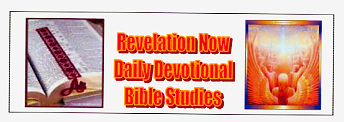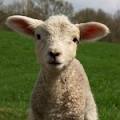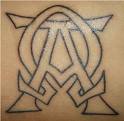
| Next | Previous | Index | Tellout Home |
51. Father's Name Written
Revelation 14.1-5
"Then I looked, and there before me was the Lamb, standing on Mount Zion, and with him 144,000 who had his name and his father's name on their foreheads. And I heard a heavenly sound like the rushing waters' roar and a thunder peal. The sound I heard was like harpists playing their harps. And they sang a new song before the throne and before the four living creatures and the elders. No one could learn the song except the earth's 144,000 redeemed. These did not defile themselves with women, for they remained virgins. They follow the Lamb wherever he goes. They were purchased from humankind and offered as first fruits to God and the Lamb. They found no lie in their mouths; they are blameless." (Revelation 14.1-5) ✞
Combined Faithful
 The 144,000 are the combined prominent faithful martyred for their faith in God and Jesus Christ. Jesus, the Lamb, stands triumphantly on Mount Zion, and with him, the "one hundred and forty-four thousand" with the Lamb's name on their foreheads. A countless host of faithful believers surround them, all of whom also had the Lamb's character and his father's name written on their foreheads. The 144,000 are from all ages, places, times and do not refer to any particular group except the twelve apostles and twelve tribes in Israel. Revelation 21.14 tells us, "The city wall had twelve foundations, and on them were the twelve apostles' names and the Lamb." The 144,000 are Jesus' faithful followers from the Old and New Testaments with his brandmark on their foreheads. ✞
The 144,000 are the combined prominent faithful martyred for their faith in God and Jesus Christ. Jesus, the Lamb, stands triumphantly on Mount Zion, and with him, the "one hundred and forty-four thousand" with the Lamb's name on their foreheads. A countless host of faithful believers surround them, all of whom also had the Lamb's character and his father's name written on their foreheads. The 144,000 are from all ages, places, times and do not refer to any particular group except the twelve apostles and twelve tribes in Israel. Revelation 21.14 tells us, "The city wall had twelve foundations, and on them were the twelve apostles' names and the Lamb." The 144,000 are Jesus' faithful followers from the Old and New Testaments with his brandmark on their foreheads. ✞
Heaven's Lion-Lamb
 Revelation includes twenty-nine references to a "lion-like lamb." John of Patmos's vision opened with Jesus' image as "God's Lamb." In John 1.29, John the Baptist sees Jesus and exclaims, "Behold God's Lamb who takes away the world's sin." The "slain but standing lamb" delivers victory like the resurrected Christ. The Lamb is worthy of taking God's scroll and opening the seals. Saint Augustine (354-430 AD), one of the most important Church Fathers, wrote in 375 AD, "Why a passionate lamb? Because he underwent death without being guilty of any iniquity. Why a lion in his passion? Because in being slain, he slew death. Why a resurrected lamb? Because of his everlasting innocence. Why a resurrected lion? Because of his everlasting might." ✞
Revelation includes twenty-nine references to a "lion-like lamb." John of Patmos's vision opened with Jesus' image as "God's Lamb." In John 1.29, John the Baptist sees Jesus and exclaims, "Behold God's Lamb who takes away the world's sin." The "slain but standing lamb" delivers victory like the resurrected Christ. The Lamb is worthy of taking God's scroll and opening the seals. Saint Augustine (354-430 AD), one of the most important Church Fathers, wrote in 375 AD, "Why a passionate lamb? Because he underwent death without being guilty of any iniquity. Why a lion in his passion? Because in being slain, he slew death. Why a resurrected lamb? Because of his everlasting innocence. Why a resurrected lion? Because of his everlasting might." ✞
People Branding
 In the ancient world, a brand upon a person had several possible meanings. Sometimes, it was an ownership mark. Often a slave was voluntarily branded with his owner's brand for loyalty and devotion. A soldier would sometimes deliberately brand his hand with his general's name, whom he loved and would follow into battle. Jesus Christ owns the faithful who are immensely loyal to him! ✞
In the ancient world, a brand upon a person had several possible meanings. Sometimes, it was an ownership mark. Often a slave was voluntarily branded with his owner's brand for loyalty and devotion. A soldier would sometimes deliberately brand his hand with his general's name, whom he loved and would follow into battle. Jesus Christ owns the faithful who are immensely loyal to him! ✞
Lamb of God's Mark
 The Lamb of God's dependents receives the Lamb's brand mark as a loyalty sign. A fourth-century papyrus letter from a son to his father named Apollo recently appeared serving in the Roman army. Times were dangerous, and the son and the father were separated. The son sent his greetings and good wishes and then added, "I have told you before of my grief at your absence from among us, and my dreadful fear that something might happen to you, and that we may not find your body. I often wished to tell you that, having regard to the insecurity, I wanted to stamp a mark upon you." The son wished to mark his father's body to identify and recover his body in a worst-case scenario after a battle. Likewise, the Lamb's company is known and marked with the Lamb's and Father's name on their foreheads. They are recoverable in life and death because they bear the Lamb's brandmark and his father's name on their foreheads. ✞
The Lamb of God's dependents receives the Lamb's brand mark as a loyalty sign. A fourth-century papyrus letter from a son to his father named Apollo recently appeared serving in the Roman army. Times were dangerous, and the son and the father were separated. The son sent his greetings and good wishes and then added, "I have told you before of my grief at your absence from among us, and my dreadful fear that something might happen to you, and that we may not find your body. I often wished to tell you that, having regard to the insecurity, I wanted to stamp a mark upon you." The son wished to mark his father's body to identify and recover his body in a worst-case scenario after a battle. Likewise, the Lamb's company is known and marked with the Lamb's and Father's name on their foreheads. They are recoverable in life and death because they bear the Lamb's brandmark and his father's name on their foreheads. ✞
Sheik's Brand
 The "Lamb brandmark" could also stand for dependence. William Robertson Smith (1846-1894), a Scottish Biblical scholar and Reader of Arabic in Christ's College, Cambridge, told how great Arab chieftains controlled his clients. Often a sheik branded a person with the same mark as his camels to show that they were wholly dependent on him. The Lamb's company are those who are utterly reliant on his love and grace and, therefore, proudly bear the Lamb's brand mark. ✞
The "Lamb brandmark" could also stand for dependence. William Robertson Smith (1846-1894), a Scottish Biblical scholar and Reader of Arabic in Christ's College, Cambridge, told how great Arab chieftains controlled his clients. Often a sheik branded a person with the same mark as his camels to show that they were wholly dependent on him. The Lamb's company are those who are utterly reliant on his love and grace and, therefore, proudly bear the Lamb's brand mark. ✞
Slave Branding
 An ownership brand mark could refer to a particular god's brand on a devotee. Branding can be very cruel. Plutarch (45-127 AD), a Greek biographer, tells us in Nicias 29, "Most of the Athenians perished in the stone quarries of disease and evil fare, their daily rations being a pint of barley meal and a half-pint of water. Many were stolen away and sold into slavery or succeeded in passing themselves off for serving men. They were branded in the forehead with a horse's mark when sold. Some freemen suffered this indignity in addition to their servitude." After the Athenians' disastrous defeat under Nicias in Sicily, the Sicilians took many captive. They branded them on the forehead with a galloping horse brand mark, Sicily's emblem. ✞
An ownership brand mark could refer to a particular god's brand on a devotee. Branding can be very cruel. Plutarch (45-127 AD), a Greek biographer, tells us in Nicias 29, "Most of the Athenians perished in the stone quarries of disease and evil fare, their daily rations being a pint of barley meal and a half-pint of water. Many were stolen away and sold into slavery or succeeded in passing themselves off for serving men. They were branded in the forehead with a horse's mark when sold. Some freemen suffered this indignity in addition to their servitude." After the Athenians' disastrous defeat under Nicias in Sicily, the Sicilians took many captive. They branded them on the forehead with a galloping horse brand mark, Sicily's emblem. ✞
Ivy Leaf Brand
 Ptolemy, the Fourth of Egypt, ordered "the demotion of all Jews to the lowest rank and the slaves' condition." Those who spoke out would be forcibly taken and killed. "Those registered were marked with an ivy leaf brand, Bacchus' emblem, Ptolemy's god." 3 Maccabees 2.28-29 referred to those with the ivy leaf branding. "Those registered will be branded with the Dionysus' ivy leaf sign on their body and given their former, limited status." The Syrians regularly tattooed slaves on the wrist or the neck with their deity's mark. The Heracles' temple at the Nile's mouth possessed the right to asylum. Any criminal, a slave, or free man, was safe from victims of their misdeeds pursuing vengeance. When a fugitive reached that temple, he was branded with sacred marks in that he had delivered himself to the deity and that none could touch him. Herodotus 2.113.2 referred to the asylum place. "Now there was (and still is) on the coast a Heracles temple; if any man's servant takes refuge and is branded with sacred marks, delivering himself to the deity, they may not touch him. This law continues today the same as it was from the first." Similarly, the Lamb and his Father's company have cast themselves on God's mercy and are safe in the Lamb's ownership. ✞
Ptolemy, the Fourth of Egypt, ordered "the demotion of all Jews to the lowest rank and the slaves' condition." Those who spoke out would be forcibly taken and killed. "Those registered were marked with an ivy leaf brand, Bacchus' emblem, Ptolemy's god." 3 Maccabees 2.28-29 referred to those with the ivy leaf branding. "Those registered will be branded with the Dionysus' ivy leaf sign on their body and given their former, limited status." The Syrians regularly tattooed slaves on the wrist or the neck with their deity's mark. The Heracles' temple at the Nile's mouth possessed the right to asylum. Any criminal, a slave, or free man, was safe from victims of their misdeeds pursuing vengeance. When a fugitive reached that temple, he was branded with sacred marks in that he had delivered himself to the deity and that none could touch him. Herodotus 2.113.2 referred to the asylum place. "Now there was (and still is) on the coast a Heracles temple; if any man's servant takes refuge and is branded with sacred marks, delivering himself to the deity, they may not touch him. This law continues today the same as it was from the first." Similarly, the Lamb and his Father's company have cast themselves on God's mercy and are safe in the Lamb's ownership. ✞
144,000
 John of Patmos looks and sees Mount Zion's Lamb before him and the 144,000 chosen faithful ones with his name and his father's name on their foreheads. The number one hundred and forty-four thousand represents the whole believers' group who have endured persecutions on earth, are pure, ready to enjoy the endless benefits and blessings of God's eternal life. These saints are numbered as twelve by twelve by one thousand. Twelve represents all humanity being three God's number and four humans' number. They are the Lamb's followers and gather on Jerusalem's Temple Mount, where he will collect Israel's faithful remnant in the messianic reign. They belong to Mount Zion's Lamb with his forehead sign, in contrast to the pagan hoards who have the beast's name or number. True believers are spiritually pure, faithful to Christ, and free from a pagan world system's involvement. They are Jesus' first fruits and dedicated as the harvest's first part as holy unto God. The 144,000 are unblemished, as are the Temple worship's sacrificial animals. These followers are worthy of singing the redeemed ones' song because of their loyalty to the Lamb, their purity, and how they resist evil even unto death. They are a particular class of people in an intimate relationship with God. Chosen for their celibacy and Lamb's devotion, they willingly accept martyrdom. "Pure" means "spiritual purity" or "chastity." They do not deny Christ or do homage to the beast. ✞
John of Patmos looks and sees Mount Zion's Lamb before him and the 144,000 chosen faithful ones with his name and his father's name on their foreheads. The number one hundred and forty-four thousand represents the whole believers' group who have endured persecutions on earth, are pure, ready to enjoy the endless benefits and blessings of God's eternal life. These saints are numbered as twelve by twelve by one thousand. Twelve represents all humanity being three God's number and four humans' number. They are the Lamb's followers and gather on Jerusalem's Temple Mount, where he will collect Israel's faithful remnant in the messianic reign. They belong to Mount Zion's Lamb with his forehead sign, in contrast to the pagan hoards who have the beast's name or number. True believers are spiritually pure, faithful to Christ, and free from a pagan world system's involvement. They are Jesus' first fruits and dedicated as the harvest's first part as holy unto God. The 144,000 are unblemished, as are the Temple worship's sacrificial animals. These followers are worthy of singing the redeemed ones' song because of their loyalty to the Lamb, their purity, and how they resist evil even unto death. They are a particular class of people in an intimate relationship with God. Chosen for their celibacy and Lamb's devotion, they willingly accept martyrdom. "Pure" means "spiritual purity" or "chastity." They do not deny Christ or do homage to the beast. ✞
"Father's Name Written"
by Ron Meacock © 2021
| ^Top Page | Next | Previous |